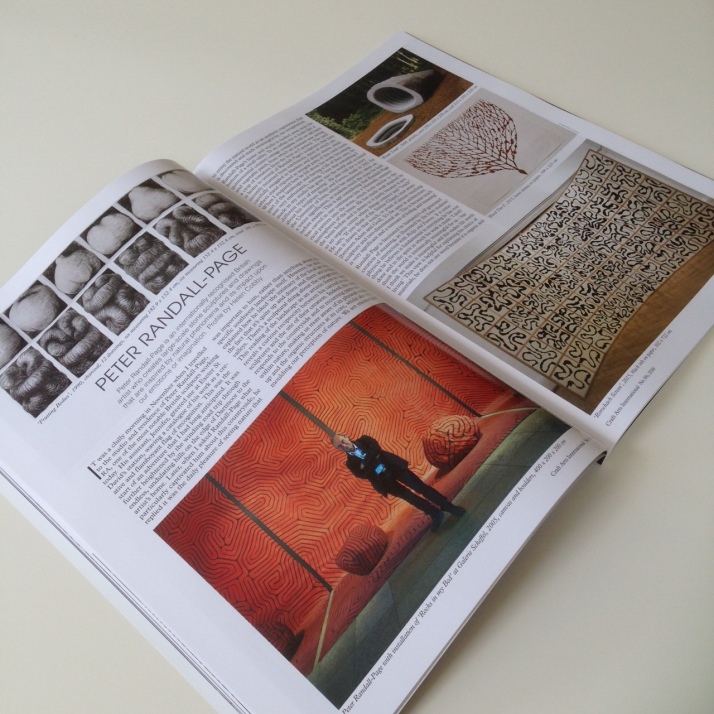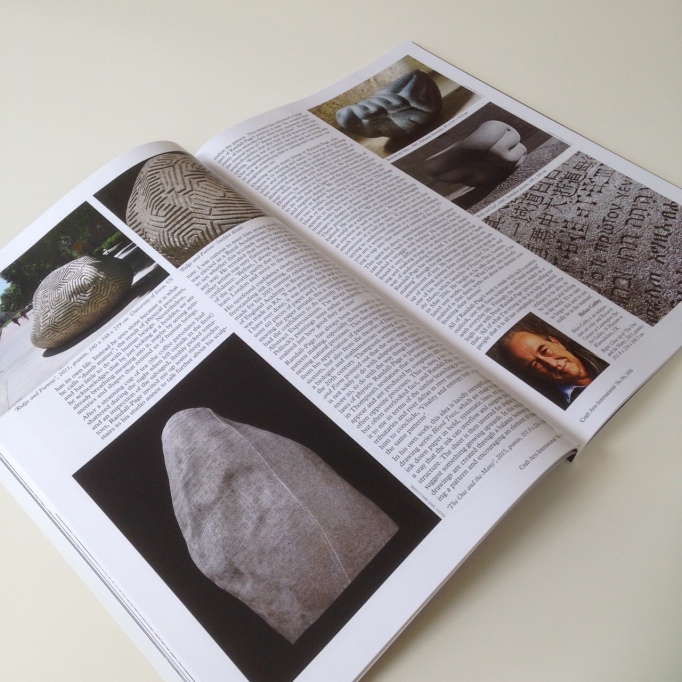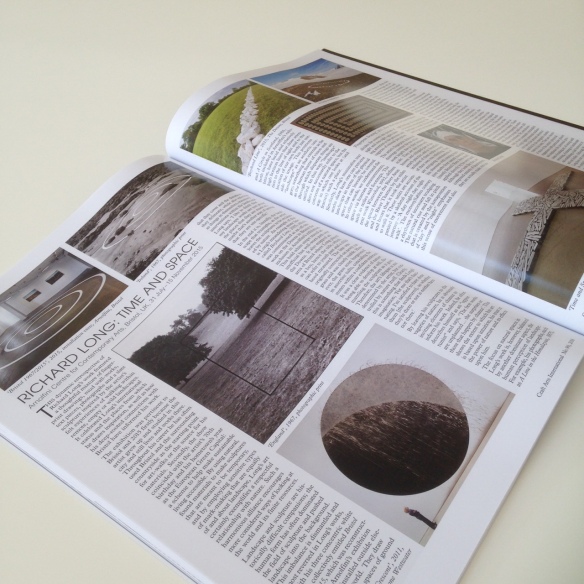 My main focus as the Research Curator at Leamington Spa Art Gallery & Museum was to research for and co-curate the gallery’s 2016 summer exhibition, ‘CONCEALMENT & DECEPTION: THE ART OF THE CAMOUFLEURS OF LEAMINGTON SPA 1939 – 1945’. This involved research trips to private collections, interviewing some of the artists’ family relatives (including writer and agony aunt Virginia Ironside), and organising and writing for the accompanying exhibition catalogue. This project was funded by the Paul Mellon Centre for Studies in British Art, and the Art Fund (a Jonathan Ruffer Curatorial Grant).
My main focus as the Research Curator at Leamington Spa Art Gallery & Museum was to research for and co-curate the gallery’s 2016 summer exhibition, ‘CONCEALMENT & DECEPTION: THE ART OF THE CAMOUFLEURS OF LEAMINGTON SPA 1939 – 1945’. This involved research trips to private collections, interviewing some of the artists’ family relatives (including writer and agony aunt Virginia Ironside), and organising and writing for the accompanying exhibition catalogue. This project was funded by the Paul Mellon Centre for Studies in British Art, and the Art Fund (a Jonathan Ruffer Curatorial Grant).
‘A camoufleur is a person who designed and implemented military camouflage in one of the world wars of the twentieth century.’ (Wikipedia)
Concealment and Deception told the story of the camouflage establishment based in Royal Leamington Spa, Warwickshire, during World War 2 (1939 – 1945). The Civil Defence Camouflage Establishment was founded at the start of the war with Nazi Germany to develop camouflage for strategically important installations like factories, power stations and airfields. Later, in 1941, the CDCE was expanded to include a Naval Camouflage Section and renamed the Camouflage Directorate. The exhibition presented the work of the camouflage staff – often known as ‘camoufleurs’ – against the backdrop of life on the ‘Home Front’.

Shots of the exhibition catalogue
Life in wartime Leamington Spa was dominated by the Home Front. This mobilisation of the civilian population to support the war effort included the rationing of food and clothes and precautions against air raids like the evening ‘blackout’. Everyone in Leamington Spa was affected, including pre-war residents and the influx of newcomers brought by the war, such as evacuees (some from nearby Coventry), workers directed to war work, soldiers of the Czech Free Army and the First Belgian Independent Brigade, and a unit of the Women’s Royal Naval Service (Wrens). The newcomers also included the often rather bohemian artists, designers and scientists employed as camoufleurs. This new temporary population, many of them young and with uncertain futures, brought an exotic vibrancy to the social life of what had previously been a sleepy midlands spa town.
At its peak the camouflage establishment employed over 230 staff, including several who went on to become some of the most influential and distinguished artists and designers of their generation. They were based in a number of buildings which had been requisitioned for the war effort. The most important were the Regent Hotel on the Parade, which became the headquarters for the CDCE and the successor Camouflage Directorate; the Roller Skating Rink by the river Leam, which became the workshop for the civil camouflage team; and the municipal Art Gallery on Avenue Road, which was taken over by the Naval Camouflage Section.
Most of the work of the civil camouflage team concerned static features like factory buildings, power station cooling towers, airfield buildings, runways and roads. Camouflage officers often photographed or sketched the sites from the air and then used these images to develop schemes to either conceal the sites or create nearby decoys to divert attacking aircraft. Simple schemes might only require plans on paper, but more elaborate designs for important sites often included the production of three-dimensional scale models. These were tested in a ‘viewing room’ in the Skating Rink, where different lighting and atmospheric conditions could be artificially recreated. If the intention was concealment, the objective was to cause the sites to merge in with their surroundings and not produce tell-tale shadows from buildings. By contrast, a decoy site might involve creating dummy aerodromes, factories and buildings, with elaborate lighting schemes to entice night-time bombing raids. Naval camouflage offered greater challenges: vessels were usually moving against a constantly changing background and left a tell-tale wake and smoke from their funnels. The approach of the naval camoufleurs was to produce scale model of the subject based on plans published in the reference book Jane’s Fighting Ships. The model would then be painted in a design intended to either make the ship less visible or, if that was impractical, confuse a prospective attacker (often a submarine) as to its type, speed and direction. The camouflage had to be designed for the typical weather conditions in which the ship would be operating, for example those found in the North Atlantic, Arctic or Pacific. The camouflaged model was then tested in a large water tank in the Art Gallery, where the likely lighting, atmospheric and marine conditions were artificially recreated. Once approved, the design would be applied to the vessel when it was nest dockside for repairs.
A number of the artists also produced paintings, watercolours and drawings recording their colleagues at work, or showing the sites and ships they had camouflaged. Other pictures showed life in the wartime town, including the damage caused by Luftwaffe bombing raids. Some artists also became involved in the production of murals in Leamington Spa, notably for the British Restaurant at the back of the Town Hall, for the Regent Hotel, and for a local school. Many joined the local branch of the Artists International Association, an organisation of artists opposed to fascism which briefly flourished in Leamington Spa as a result of the concentration of camoufleurs. The friendships formed during the war influenced the later careers of many of the staff who had worked together in Leamington Spa.
The exhibition included an important group of paintings, watercolours and drawings loaned by the Imperial War Museum, complemented by others from Leamington Spa Art Gallery & Museum, the Herbert Art Gallery (Coventry), the Henry Moore Institute Leeds, and from private collections. Artists featured include Mary Adshead, Dorothy Annan, Stephen Bone, Louis Duffy, Evelyn Dunbar, Eric Hall, Cedric Kennedy, Edwin La Dell, Colin Moss and James Yunge-Bateman. Their work was displayed alongside clothing, equipment and documents relating to the Home Front in Leamington Spa.
The project drew on over two decades of research carried out locally and nationally to piece together the story of Leamington Spa’s extraordinary but little known contribution to the defeat of Nazi Germany and its allies. The title of the exhibition and the published catalogue echoes that of the government body set up during the war to oversee camouflage: the ‘Committee on Concealment and Deception’.
***********
We received good local press coverage, including the features below:
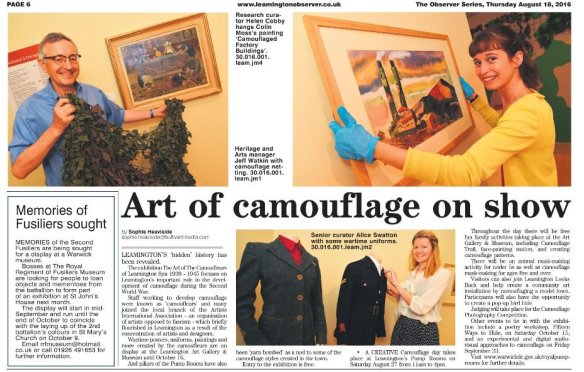

The exhibition also received coverage in some of the hometowns of the camouflage artists, like the article below, which featured camoufleur Colin Moss:

Colin Moss’ grandson visited the exhibition with his family, and started a Facebook page about his artist grandfather.
The writer and agony aunt Virginia Ironside also mentioned the exhibition in several of her magazine columns. She is the daughter of Christopher Ironside, one of the camouflage artists, who went on to become the designer of the UK’s first decimal coins. Below she mentions the exhibition at the beginning of her column in The Spectator:

Virginia mentioned the camouflage exhibition in her column in The Spectator
Virginia ironside also included her experience of coming to see the exhibition and explore her old hometown Leamington Spa in her article for The Oldie:
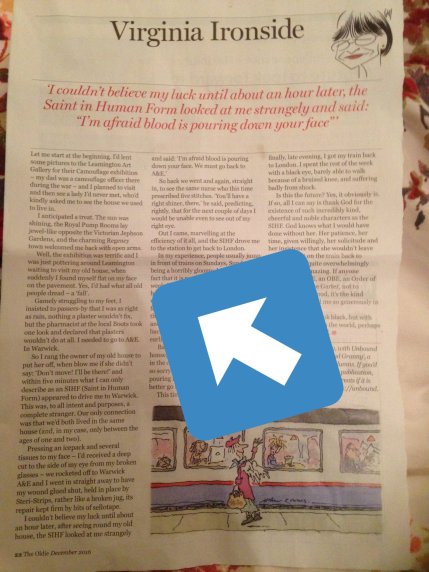
Local artists were inspired by the exhibition, producing camouflage-themed yarn bombing on the columns outside the Pump Rooms, which contains Leamington Spa Art Gallery & Museum:
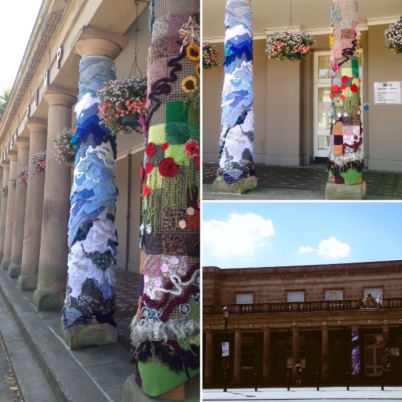

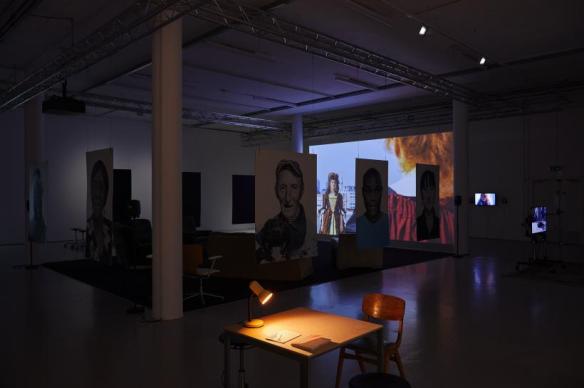
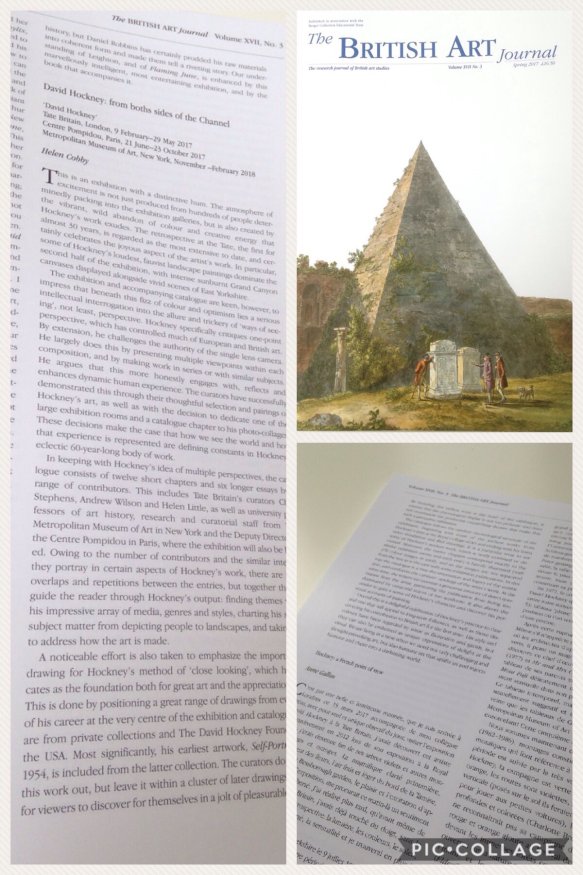
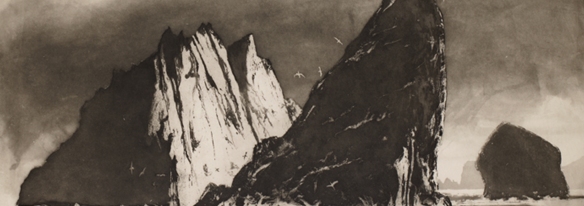






 My main focus as the Research Curator at Leamington Spa Art Gallery & Museum was to research for and co-curate the gallery’s 2016 summer exhibition, ‘CONCEALMENT & DECEPTION: THE ART OF THE CAMOUFLEURS OF LEAMINGTON SPA 1939 – 1945’. This involved research trips to private collections, interviewing some of the artists’ family relatives (including writer and agony aunt Virginia Ironside), and organising and writing for the accompanying exhibition catalogue. This project was funded by the Paul Mellon Centre for Studies in British Art, and the Art Fund (a Jonathan Ruffer Curatorial Grant).
My main focus as the Research Curator at Leamington Spa Art Gallery & Museum was to research for and co-curate the gallery’s 2016 summer exhibition, ‘CONCEALMENT & DECEPTION: THE ART OF THE CAMOUFLEURS OF LEAMINGTON SPA 1939 – 1945’. This involved research trips to private collections, interviewing some of the artists’ family relatives (including writer and agony aunt Virginia Ironside), and organising and writing for the accompanying exhibition catalogue. This project was funded by the Paul Mellon Centre for Studies in British Art, and the Art Fund (a Jonathan Ruffer Curatorial Grant).












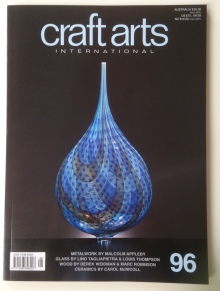 I have two articles published in Craft Arts International magazine, issue no. 96, June 2016.
I have two articles published in Craft Arts International magazine, issue no. 96, June 2016.